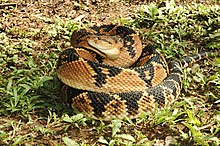Lachesis muta
| Lachesis muta | |
|---|---|
 |
|
| Scientific classification | |
| Kingdom: | Animalia |
| Phylum: | Chordata |
| Subphylum: | Vertebrata |
| Class: | Reptilia |
| Order: | Squamata |
| Suborder: | Serpentes |
| Family: | Viperidae |
| Subfamily: | Crotalinae |
| Genus: | Lachesis |
| Species: | Lachesis muta |
| Binomial name | |
|
Lachesis muta (Linnaeus, 1766) |
|
| Synonyms | |
|
|
Lachesis muta is a venomous pit viper species found in South America (including the island of Trinidad in the Republic of Trinidad and Tobago). Two subspecies are currently recognized, including the nominate subspecies described here.
Adults grow to an average of 2 to 2.5 m (6½-8 feet), although 3 m (10 feet) is not too unusual. The largest recorded specimen was almost 3.65 m (12 feet) long, making this the largest of all vipers and the longest venomous snake in the western hemisphere. Lachesis muta is the 3rd longest venomous snake in the world. Weight in this species is estimated at 3 to 5 kg (6.6 to 11.0 lb), somewhat less than the heaviest rattlesnakes or Bitis vipers.
The head is broad and distinct from the narrow neck. The snout is broadly rounded. There is no canthus. A pair of small internasals is present, separated by small scales. The supraoculars are narrow. Other parts of the crown are covered with very small scales. Laterally, the second supralabial forms the anterior border of the loreal pit, while the third is very large. The eye is separated from the supralabials by 4-5 rows of small scales.
The body is cylindrical, tapered and moderately stout. Midbody there are 31-37 nonoblique rows of dorsal scales which are heavily keeled with bulbous tubercles and feebly imbricate. There are 200-230 ventral scales. The tail is short with 32-50 mainly paired subcaudals, followed by 13-17 rows of small spines and a terminal spine.
The color pattern consists of a yellowish, reddish or grey-brown ground color, overlaid with a series of dark brown or black dorsal blotches that form lateral inverted triangles of the same color. The lateral pattern may be precisely or indistinctly defined, normally pale at the center.
...
Wikipedia
